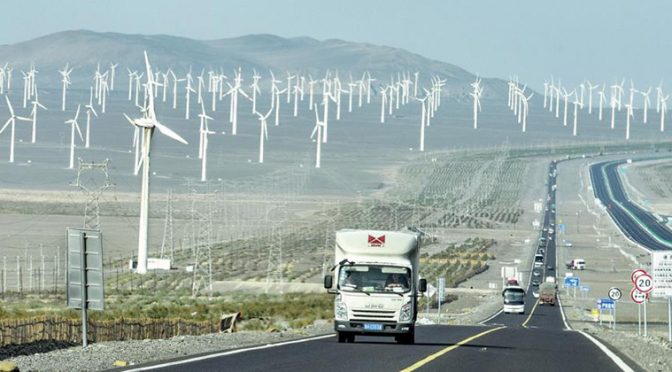China is shoring up its position as the world leader in renewable power and potentially outpacing its own ambitious energy targets, a report has found.
China is set to double its capacity and produce 1,200 gigawatts of energy through wind and solar power by 2025, reaching its 2030 goal five years ahead of time, according to the report by Global Energy Monitor, a San Francisco-based NGO that tracks operating utility-scale wind and solar farms as well as future projects in the country.
It says that as of the first quarter of the year, China’s utility-scale solar capacity has reached 228GW, more than that of the rest of the world combined. The installations are concentrated in the country’s north and north-west provinces, such as Shanxi, Xinjiang and Hebei.
In addition, the group identified solar farms under construction that could add another 379GW in prospective capacity, triple that of the US and nearly double that of Europe.
China has also made huge strides in wind capacity: its combined onshore and offshore capacity now surpasses 310GW, double its 2017 level and roughly equivalent to the next top seven countries combined. With new projects in Inner Mongolia, Xinjiang, Gansu and along coastal areas, China is on course to add another 371GW before 2025, increasing the global wind fleet by nearly half.
“This new data provides unrivalled granularity about China’s jaw-dropping surge in solar and wind capacity,” said Dorothy Mei, a project manager at Global Energy Monitor. “As we closely monitor the implementation of prospective projects, this detailed information becomes indispensable in navigating the country’s energy landscape.”
The findings are in line with previous reports and government data released this year, which predicted that China could easily surpass its target of supplying a third of its power consumption through renewable sources by 2030.
China’s green energy drive is part of its effort to meet dual carbon goals set out in 2020. As the world’s second largest economy, it is the biggest emitter of greenhouse gases and accounts for half of the world’s coal consumption. The Chinese president, Xi Jinping, pledged in 2020 to achieve peak CO2 emissions before 2030 and carbon neutrality by 2060.
The report attributed China’s remarkable progress in expanding its non-fossil energy sources to the range of policies its government has implemented, including generous subsidies to incentivise developers as well as regulations to put pressure on provincial governments and generating companies.
China began operating the world’s largest hybrid solar-hydro power plant in the Tibetan plateau on Sunday. Named Kela, the plant can produce 2bn kW hours of electricity annually, equal to the energy consumption of more than 700,000 households.
Itis only the first phase of a massive clean energy project in the Yalong River basin. The installation has a 20GW capacity now and is expected to reach about 50GW by 2030.
Despite China’s careful planning, its energy transition is not without its challenges. In recent years, record heatwaves and drought crippled hydropower stations, resulting in power crunches that brought factories to a halt. An outdated electricity grid and inflexibility in transferring energy between regions add to the uncertainty.
The Kela plant is located in the sparsely populated west of the country, where more than three-quarters of coal, wind and solar power is generated. But the vast majority of energy consumption happens in the east. Transporting energy thousands of miles across the country results in inefficiencies.
The way China’s grid is organised can incentivise building coal plants around renewable generators. Much of the new renewable capacity is not connected to the local energy supply and often bundled with coal power to be transmitted to areas of higher demand.
More coal power was approved in the first three months of 2023 than in the whole of 2021.
“China is making strides,” said Martin Weil, a researcher at Global Energy Monitor and an author of the report. “But with coal still holding sway as the dominant power source, the country needs bolder advancements in energy storage and green technologies for a secure energy future.”
Amy Hawkins and Rachel Cheung, theguardian.com


